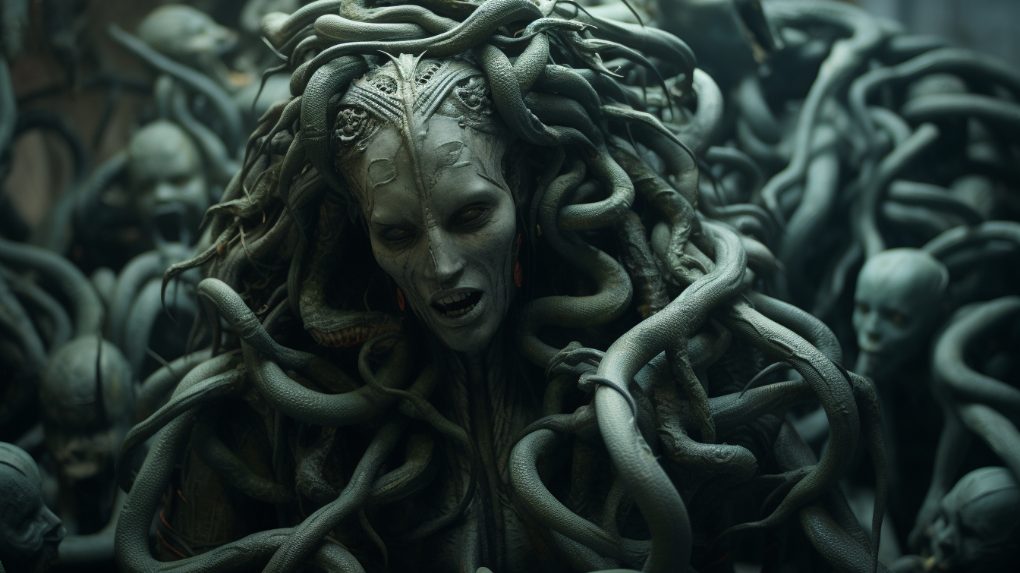The terrifying figures of the Gorgons pervade ancient Greek mythology, representing the fearsome aspect of the divine and the grotesque.
These mythical beings, often described with hair of living, venomous snakes, and the ability to turn living creatures into stone with their gaze, occupied a significant role in the myths and protective practices of ancient Greece. They were particularly associated with certain religious rituals and temples, which highlighted their ominous power and close association with the gods.
The Origin of the Gorgons
Hesiod’s Theogony: The Ancient Source
Our earliest detailed reference to the Gorgons comes from Hesiod’s “Theogony,” a seminal work that charts the birth of the gods and the creation of the world. In this epic, the Gorgons are three sisters—Medusa, Stheno, and Euryale—born to the ancient marine deities Phorcys and Ceto, somewhere far in the Western Ocean, a realm associated with the unknown and the uncanny. Unlike other monstrous figures depicted in Greek myths, the Gorgons were not simply creatures to be battled and overcome. They were a primal force, a divine punishment, and a protective presence.
The Three Sisters: Diverging Tales
Though Hesiod introduces the Gorgons as a trio, it’s Medusa—whose name derives from an ancient Greek word meaning “guardian” or “protectress”—who stands out due to her unique traits. Her sisters were immortal, but Medusa was not. Ancient sources suggest varying reasons for this discrepancy, contributing to a rich tapestry of narratives that evolved and diverged throughout the history of Greek storytelling.
Don't miss The Mystical World of Hippogriffs
Medusa: The Only Mortal Gorgon
Medusa’s Curse: Beauty to Monstrosity
Originally, Medusa was a ravishingly beautiful maiden, with lovely hair and features that caught the attention of many suitors. Her beauty, however, also caught the eye of Poseidon, the mighty god of the sea. According to one version of the myth, Poseidon desecrated Athena’s temple by engaging in an illicit affair with Medusa there. Enraged, the goddess Athena transformed Medusa’s beautiful hair into hideous snakes and made her face so terrible to behold that the mere sight of it would turn onlookers to stone. This transformation from beauty to beast underscores the complex interplay of divinity, punishment, and envy in ancient Greek culture.
The Complex Character of Medusa in Myths
As the only mortal among the Gorgons, Medusa’s story is often one of sympathy and nuanced morality. She is not a monster by choice but by curse, and her backstory offers rich material for interpretations related to power, violation, and sovereignty. Her terrifying aspect hides a history of victimhood, a theme that ancient authors sometimes explore with reluctance and contemporary authors often emphasize, revealing the shifting mores across times.
Further Insights into Gorgon Mythology
The Unique Curse of Medusa
Among the three monstrous sisters, it was only Medusa who was cursed with mortality and a gaze that turned onlookers to stone, a punishment bestowed upon her by Athena. This aspect of the myth underscores Medusa’s distinctive suffering compared to her immortal sisters, an element often explored in classical interpretations of the story. Her once beautiful hair transformed into a nest of venomous snakes, her face contorted into a visage of horror, Medusa became an icon of cursed beauty and tragic fate.
Perseus’s Divine Arsenal
The success of Perseus’s mission relied heavily on divine intervention. Before he ventured into the lair of the Gorgons, Perseus received crucial items from the gods. Hermes provided him with a pair of winged sandals for swift travel, while Zeus bestowed upon him a golden sword, sharper than any mortal weapon. It was with this divine arsenal that Perseus overcame Medusa, underscoring the common interpretation of humans acting with divine aid in ancient Greek myths.
Iconography: Gorgons in Ancient Greek Art
Medusa’s Visage: From Gorgon to Beautiful Maiden
In ancient Greek art, Medusa has undergone several transformations, reflecting various cultural, religious, and societal attitudes. Initially represented as a hideous beast with protruding tongue, wild hair, and fearsome tusks, her image softened over time. By the Classical period, particularly in the fifth century, Medusa was depicted more humanely—a beautiful maiden with snakes in her hair, sometimes sad or reflective. This shift in portrayal from monstrous to almost pitiful suggests a complex understanding of her story among the ancients, influencing her depictions in sculptures, engravings, and on the shields of warriors seeking protection.
Gorgons in the Known Greek World: Attic Vase and Beyond
The Gorgons, especially Medusa, were popular figures in the realm of ancient Greek art, prominently featured on temple pediments, pottery, and domestic artifacts. One example, found on an Attic vase, showcases a fierce, stylized Gorgon, emphasizing the protective function these beings served. Their images were not limited to fearful adornments but were symbols invoking the divine safeguard against evil, harnessed for both their petrifying horror and their power to ward off harm.
Also read The Fiji Mermaid: The P.T. Barnum Hoax That Lives On
Gorgons in Historical Artifacts and Literature
Roman Cameo and First Century Artistry
The influence of Gorgon mythology extended well into Roman culture. A significant artifact, a Roman cameo dating back to the first century, depicts Perseus holding Medusa’s head, symbolizing victory over chaos and danger. This piece, along with others found in various excavations, signifies the continuation and adaptation of Greek mythological themes in Roman art and literature, emphasizing the cultural exchange and preservation of these stories through artistic expression.
Medusa at the Metropolitan Museum
In a more contemporary setting, the legacy of Medusa and the Gorgons can be witnessed in institutions like the Metropolitan Museum of Art. Among its extensive collections, the museum houses ancient Greek pottery and sculptures, including depictions of the three Gorgons and the heroic acts of Perseus. These historical pieces serve not only as a testament to the artists of antiquity but also as a narrative medium through which these ancient myths speak to modern audiences.
The Myth of Perseus and Medusa
Perseus: The Hero’s Quest
Perseus, one of the most celebrated heroes of Greek mythology, embarked on the perilous quest to slay Medusa at the behest of King Polydectes. Equipped with gifts from the gods, including a reflective shield from Athena, winged sandals from Hermes, a cloak of invisibility, and a magical bag to safely contain Medusa’s head, Perseus traversed realms in his pursuit. His journey, fraught with divine interventions and mythical encounters, underscores the intricate interplay between gods and mortals in achieving heroic feats.
The Slaying of Medusa: A Detailed Chronicle
When Perseus arrived at the Gorgons’ lair, he approached Medusa while she was asleep, using the reflection in Athena’s polished shield to avoid looking directly at her and being turned to stone. With precision and swiftness, he severed her head, and from the blood that spurted forth, the winged horse Pegasus and the giant Chrysaor were born, both children of Poseidon. The hero escaped unharmed, using Medusa’s head as a weapon when necessary, highlighting his cunning and bravery in the face of such potent, divine terror.
Don't miss The Mystical World of Hippogriffs
Aftermath: The Significance of Medusa’s Severed Head
Perseus and Andromeda: The Journey Continues
With Medusa’s severed head in his possession, Perseus continued his heroic endeavors. He famously used its petrifying power to rescue the princess Andromeda from a sea monster sent by Poseidon to ravage her kingdom as divine punishment. The theme of using spoils from divine or heroic conquests to achieve further glory is common in Greek myths, highlighting the ancients’ belief in an interconnected narrative between gods, monsters, and mortals.
Uses of Medusa’s Head in Greek and Roman Mythology
The potency of Medusa’s head, known for turning those who gazed upon it to stone, features prominently in ancient mythology beyond Perseus’s tale. It is said that Perseus gave Medusa’s head to Athena, who placed it on her shield, the Aegis, symbolizing a higher protective power. This iconography was not only central in Greek mythology but also adopted by the Romans. The Roman equivalent of Athena, Minerva, was similarly depicted bearing the Gorgon’s visage on her breastplate, illustrating the transition and adaptation of symbolic motifs in mythology across cultures.
Gorgons Beyond Medusa: Stheno and Euryale
Other Gorgons: Quasi-Historical Myths or Factual Cryptids?
Medusa’s sisters, Stheno and Euryale, often overshadowed by the popular image of Medusa, carry their own significance in mythology. Descriptions of their immortality and ferocity suggest a quasi-historical attempt by ancient Greeks to rationalize the unknown aspects of their world, perhaps categorizing the sisters alongside cryptids, creatures believed to exist based on anecdotal evidence but lacking solid proof. This approach to understanding the Gorgons hints at an early form of integrating mythology with natural history and exploration.
The Power of the Monstrous Sisters
Stheno and Euryale, renowned for their aggressive natures and the shrill cries that could send fear into the hearts of mortals, were far more than mere background figures in Medusa’s tale. They were formidable entities in their own right. While much of the focus in art and literature centers on Medusa, ancient sources often allude to the collective strength of the three Gorgon sisters, suggesting a more unified mythological front against threats, both mortal and divine.
Interpretations and Theories on Gorgon Medusa
Philosophical and Psychological Readings of the Medusa Myth
The Medusa myth has been ripe for interpretation, from Freud’s famous analysis relating Medusa’s head to the so-called castration complex to later philosophical and critical theories. Her transformation from a beautiful maiden to a monster, her petrifying visage, and the subsequent use of her severed head as both weapon and protective emblem have served as powerful metaphors for themes ranging from the male gaze to shifts in power dynamics.
Feminist Perspectives: Reclaiming Medusa
Feminist readings of Medusa’s story have gained traction in modern times, viewing her not as a monstrous figure but as a victim of Athena’s wrath and Poseidon’s lust. This perspective highlights her agency, or lack thereof, and her enforced role as a terror-inducing entity. For some, Medusa is a tragic figure, her story echoing the experiences of many women subject to the whims and punishments of a patriarchal society, thereby turning a monster into a symbol of shared trauma and resistance.
Medusa’s Legacy in Art and Pop Culture
From Ancient Artifacts to Modern Metaphors
The figure of Medusa, once a protective image, has evolved throughout the centuries. In ancient Greece, her petrifying visage was a common motif in art and architecture, designed to ward off evil. This practice was particularly prominent in places of worship and noble houses, establishing a spiritual and societal significance.
In modern times, Medusa has transcended her origins in mythology, becoming a staple in various forms of media and contemporary art. Her story has been reinterpreted through numerous lenses, making her a versatile figure representing themes ranging from horror to empowerment. From her appearance in high fashion designs to her symbolic presence in social movements, Medusa remains a powerful icon in the collective consciousness.
Medusa in Literature and Academic Pursuits
Medusa continues to be a subject of fascination in academic circles, with scholars examining her myth through various disciplines. Publications from renowned academic presses, such as Oxford University Press, Cambridge University Press, and Princeton University Press, have contributed to the discourse, exploring themes of transformation, power, and gender dynamics inherent in her story.
Moreover, Medusa’s narrative has inspired countless literary works over the centuries, reflecting society’s changing values and understanding. Her complex character allows for deep analysis and creative expression, reinforcing her status as an enduring figure in cultural and intellectual contexts.
You may also like Ghouls, Hellhounds, and Devil Dogs Tales of the Occult
Conclusion: The Gorgons’ Enduring Allure
The Gorgons, particularly Medusa, have captivated human imagination for millennia. Originating from a realm of myth and ancient religious practice, these figures have journeyed into our modern imagination, reinventing themselves to fit contemporary narratives. Their transformation from dreaded monsters to complex symbols of various social issues illustrates the fluid nature of myths and their ability to adapt to the needs and fears of society.
In many ways, the Gorgons encapsulate the human experience — our fears, our sympathies, and our ability to find humanity in the monstrous. They remind us that there is often more beneath the surface, encouraging deeper exploration of the stories we believe and the characters we fear.
From ancient Greek art to the philosophical debates of the modern world, the Gorgons remain relevant, their stories resonating with timeless themes of power, transformation, and the divine. Their legacy, preserved through art, literature, and the boundless realm of human creativity, continues to challenge and inspire us, proving that myths are not just tales of the past but living narratives that shape and are shaped by human culture.



